Cut and Paste — Big Time!
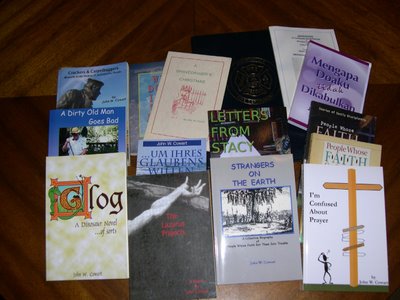
You’d never guess it from reading my journal but books excite me.
I read them. I write them. I admire them.
But I watch tv too and the tv weather report Thursday night started this train of thought for me:
I knew it was warm here in Florida before I even turned on the tv. Then the weather guy told me how hot it really is. He said, “The Heat Index today reached 110 degrees”.
What’s he talking about?
Have you ever heard any human being except a tv weather guy say the phrase “heat index”? When I looked at the back porch thermometer, it only read 96 degrees. That’s the real temperature. But television, in its determination to increase viewers’ anxiety level, has to make the heat sound even worse than it really is.
I believe those in control of tv stations have that agenda.
That’s my rant.
So broadcasters use terms like heat index in summer to make it sound hotter, and wind-chill factor in winter to make you feel colder than you really are, I thought.
Never heard the term wind-chill factor anywhere other than on tv either.
Ahgggggh! I thought.
Wind Chill Factor! I thought.
Winter is coming, I thought.
Christmas is coming, I thought. And here it is August already I still haven’t put together my Christmas book!
In order to have a Christmas book ready for the market before Thanksgiving shopping season, I need to kick in the afterburners or I will be too close to Christmas for readers to be able to buy my book in time to send it as a gift.!
That alarming realization startled me.
For ages I have intended to slap together carefully craft some of my columns and holiday magazine articles into a single Christmas book. But I keep putting the project off and I never get around to actually gluing the thing together. assembling the manuscript.
So, Friday, I stayed out of the heat by working on a Christmas book from bits and pieces and magazine articles I’ve already written. (Never sell anything but one-time rights to any magazine so you retain your copyright).
I know that each article makes a stand-alone chapter for the book all I have to do is cut and paste and string them together.
But, when I did that at first only an 86-page manuscript resulted.
Rats!
That’s not long enough for a book… let me think.
I know. I’ll add Thanksgiving articles. Halloween articles. Easter articles, 4th of July, Veteran’s Day…. It will be a Holiday book. I’ve been writing this sort of thing for 20+ years, so I have plenty of material.
Again I pasted.
Now the rough draft of the holiday book came to 228 pages. Not too shabby. By the time I edit, add graphics, proofread, get an ISBN, design the cover, write the promo text, register copyright with LC, and all that, this book should be ready — by the 4th of July!
But that’s only if I put the Civil War Diary, my Fire Department History, my Dirty Old Man Gets Worse manuscript and my entire life on hold, dropping everything else and concentrating on just the holiday book.
It’s going to be a cold day in — Somewhere they don’t usually talk about a wind chill factor — before I get all that done.
Yes, books excite me. So this morning when I stumbled across a web site about the Archimedes Palimpsest, it thrilled me!
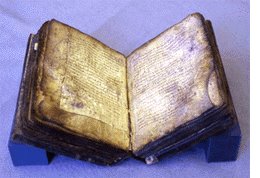
You can read all about it at http://www.archimedespalimpsest.org/ . Their site is wonderful! Great! Don’t miss checking it out. It’s thrilling.
Now you should know that I know less Greek than a radish. I took first semester Greek four times in college failing the course each time. Hey, it was a 7 a.m. class after I’d worked till 2 a.m. each night. At least that’s my excuse.
But scholars at the Department of Energy's Stanford Linear Accelerator Center have unraveled a Tenth Century Greek manuscript of a text by the mathematician Archimedes.
Like many biblical manuscripts, the Archimedes Palimpsest was written on velum, a sort of paper made of animal skin. Since velum was a rare and expensive material, in some ancient time, a scribe decided to scrap the ink off the book’s pages, cut them into smaller sheets, turn them sideways, and write a new text on those pages. Thus making a new book.
But his cutting and pasting destroyed the old one.
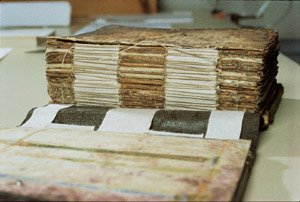
Here’s what a news report from the eetimes http://www.eetimes.com/news/semi/showArticle.jhtml?articleID=191800682 said:
SAN JOSE, Calif. — Using X-ray imaging technology, the Department of Energy's Stanford Linear Accelerator Center (SLAC) claims to have deciphered the last unreadable pages of the works from ancient mathematician Archimedes.
Scientists at SLAC (Menlo Park, Calif.) used X-ray fluorescence (XRF) imaging technology to decipher Archimedes' "scientific secrets" written on goatskin parchment manuscripts. Until now, the manuscripts have been unreadable for more than 1,000 years. …
The text of the "Archimedes Palimpsest" presented a major challenge to decode. In the 10th century, an anonymous scribe copied Archimedes' treatises in the original Greek onto the parchment.
Three centuries later, a monk was said to have "palimpsested" the parchment. In doing so, the monk scraped away the Archimedes text, cut the pages in half, turned them sideways and copied Greek Orthodox prayers onto the recycled pages. The result was the near obliteration of Archimedes' work, except for the faintest traces of ink still embedded in the parchment.
In 1998, this manuscript was purchased by an anonymous collector at international auction, who then entrusted it to the care of The Walters Art Museum (Baltimore, Md.).
Using modern imaging techniques, the faint traces of the remaining original ink brought to light stunning discoveries about Archimedes, according to SLAC. But certain pages resisted even the most intensive attempts at deciphering, according to SLAC.
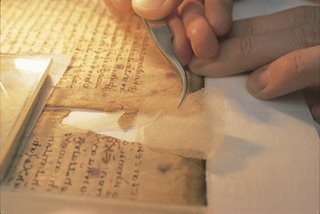
This display of scholarship and technology awes me.
I have know about palimpsest Bible manuscripts for years and I have seen a couple in museums. Bible scholars have recovered many such texts. But to see how these great scholars at SLAC have treated this mathematics text — well, it just blows my mind.
King Solomon said, “Of the making of many books there is no end, and much study is a weariness of the flesh”.
Maybe so.
But I like books.
I can tear them apart and paste them back together too.
I feel like I’m part of a great tradition.
Please, visit my website for more www.cowart.info and feel free to look over and buy one of my books www.bluefishbooks.info
posted by John Cowart @ 5:59 AM
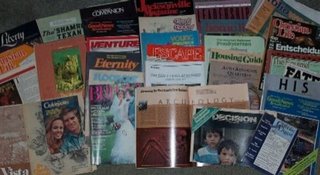


3 Comments:
Yay Books! I've read 32 of them so far this summer. The second edition of my textbook is out. Books are the best. My daughter taught me to always have one in my backpack for emergencies: airport layovers, waiting in the doctor's office, waiting in the train station, riding the bus. They say everyone has at least one book in them. Maybe someday I'll do a second.
I disagree with career guy. I think everyone THINKS they have at least one book in them. People idly state their intentions to 'one day' write a book, as though it were as easy as sneezing, or eating an apple.
John, you are one of those who actually has the talent, and the persistence, to write books. It's only right you should feel part of a great tradition. Good on you, author!
This was fascinating information. Although I've only been making simple books, I've learnt about the different parts of the book and how they're constructed. I recognised how that ancient book was sewn together. One of the binding styles I've learnt is Coptic binding, it is such a beautiful technique and has been in existence for so long. Thanks for this, John!
Post a Comment
<< Home